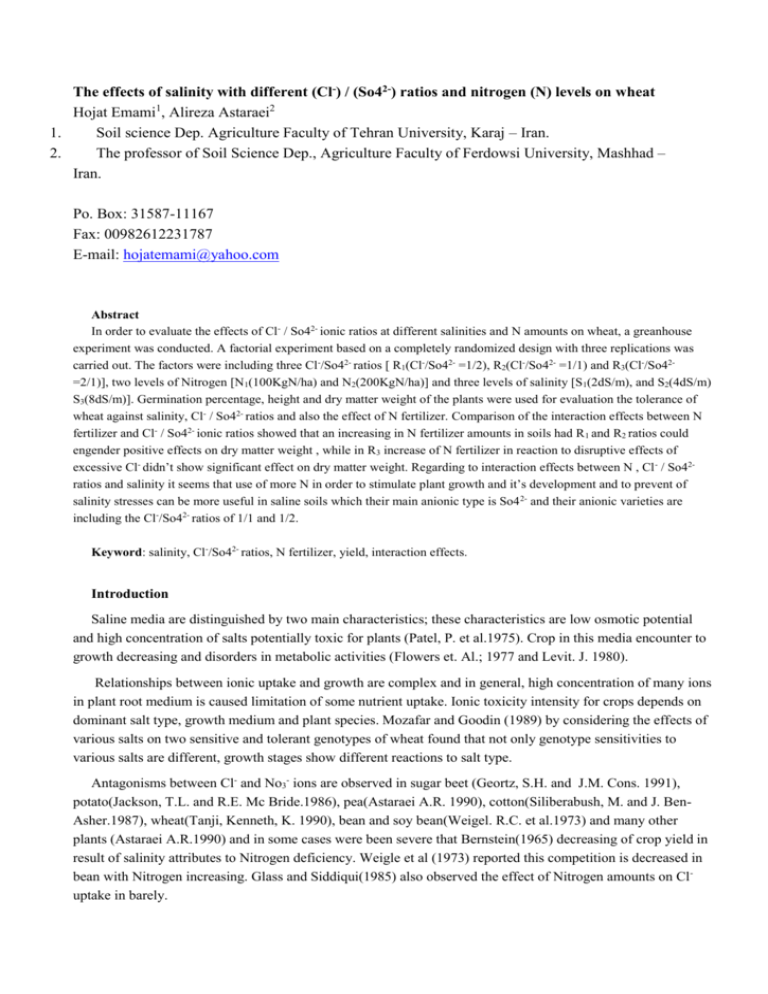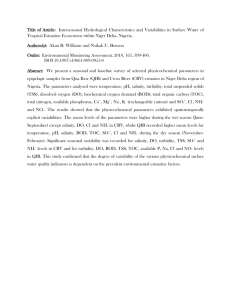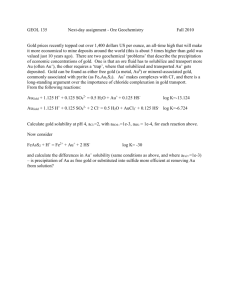Introduction
advertisement

The effects of salinity with different (Cl-) / (So42-) ratios and nitrogen (N) levels on wheat Hojat Emami1, Alireza Astaraei2 1. Soil science Dep. Agriculture Faculty of Tehran University, Karaj – Iran. 2. The professor of Soil Science Dep., Agriculture Faculty of Ferdowsi University, Mashhad – Iran. Po. Box: 31587-11167 Fax: 00982612231787 E-mail: hojatemami@yahoo.com Abstract In order to evaluate the effects of Cl- / So42- ionic ratios at different salinities and N amounts on wheat, a greanhouse experiment was conducted. A factorial experiment based on a completely randomized design with three replications was carried out. The factors were including three Cl-/So42- ratios [ R1(Cl-/So42- =1/2), R2(Cl-/So42- =1/1) and R3(Cl-/So42=2/1)], two levels of Nitrogen [N1(100KgN/ha) and N2(200KgN/ha)] and three levels of salinity [S1(2dS/m), and S2(4dS/m) S3(8dS/m)]. Germination percentage, height and dry matter weight of the plants were used for evaluation the tolerance of wheat against salinity, Cl- / So42- ratios and also the effect of N fertilizer. Comparison of the interaction effects between N fertilizer and Cl- / So42- ionic ratios showed that an increasing in N fertilizer amounts in soils had R 1 and R2 ratios could engender positive effects on dry matter weight , while in R3 increase of N fertilizer in reaction to disruptive effects of excessive Cl- didn’t show significant effect on dry matter weight. Regarding to interaction effects between N , Cl - / So42ratios and salinity it seems that use of more N in order to stimulate plant growth and it’s development and to prevent of salinity stresses can be more useful in saline soils which their main anionic type is So4 2- and their anionic varieties are including the Cl-/So42- ratios of 1/1 and 1/2. Keyword: salinity, Cl-/So42- ratios, N fertilizer, yield, interaction effects. Introduction Saline media are distinguished by two main characteristics; these characteristics are low osmotic potential and high concentration of salts potentially toxic for plants (Patel, P. et al.1975). Crop in this media encounter to growth decreasing and disorders in metabolic activities (Flowers et. Al.; 1977 and Levit. J. 1980). Relationships between ionic uptake and growth are complex and in general, high concentration of many ions in plant root medium is caused limitation of some nutrient uptake. Ionic toxicity intensity for crops depends on dominant salt type, growth medium and plant species. Mozafar and Goodin (1989) by considering the effects of various salts on two sensitive and tolerant genotypes of wheat found that not only genotype sensitivities to various salts are different, growth stages show different reactions to salt type. Antagonisms between Cl- and No3- ions are observed in sugar beet (Geortz, S.H. and J.M. Cons. 1991), potato(Jackson, T.L. and R.E. Mc Bride.1986), pea(Astaraei A.R. 1990), cotton(Siliberabush, M. and J. BenAsher.1987), wheat(Tanji, Kenneth, K. 1990), bean and soy bean(Weigel. R.C. et al.1973) and many other plants (Astaraei A.R.1990) and in some cases were been severe that Bernstein(1965) decreasing of crop yield in result of salinity attributes to Nitrogen deficiency. Weigle et al (1973) reported this competition is decreased in bean with Nitrogen increasing. Glass and Siddiqui(1985) also observed the effect of Nitrogen amounts on Cluptake in barely. These evidences show that antagonism between Cl- and So42- is interactive. The mechanism of this competition is not exactly clear, but seems that it is been the result of Na+ preventative effects (Siliberabush, M. and J. Ben- Asher;1987), because No3- ion moves from roots to leaves by xylem and K has a stimulator effect in this process. Whenever excessive Na+ and Cl- ions enter into the vesicular system, Na+ ion prevents of K+ uptake. Decreasing of K+ decreases the transferring of No3 and as a result of this activity Cl- anion transfers instead of No3- into the leaves and concentrates there (Mass , E. V. and G. Y. Haffman;1997; Siliberabush, M. and J. Ben- Asher;1987). The aim of this study is to evaluate the effect of different levels of salinity on wheat injurious because Cland So42- anions are the salinity factors in most places and Cl- importance on injury appearance in relation to other ions present in saline condition is considerable , more notice has been focused on this anions and on the effect of Nitrogen fertilizer too. Material and methods Laboratory studies The soil sampled from 0-15 Cm, then air dried and passed a 2 mm sieve. (Silt Clay Loam EC=0.5dS/m. Regarding to treatment and replications, soil sample as equal content had put on polyethelene culvert pipes with inner diameter 12 Cm and length of 60 Cm. In this study, solutions included 2 , 4 and 8 dS/m salinity levels and 1/2 , 1/1 and 2/1 Cl-/So42- ratios was prepered via dissolving certain amounts of Calcium Chloride(CaCl2) and Calcium Solphate (CaSo4) in distilled water. These solutions were used to leach the soil. Soil leaching was conducting twice a week for two month. After every leaching, the leachate of soil was collected and the hydroulic conductivity (EC) of its was measured. When the EC of leachate was equaled to solutions, the leaching activity was stoped. Soil columns after air drying was grinded and passed a 2 mm seive. Greenhouse studies In this stage the effect of salinity stress, Cl-/So42- ionic ratios and probable effects of Nitrogen on germination percentage, heigth and dry matter weigth of wheat was studied in pot and greenhouse condition. In addition to three levels of salinity and three ionic ratio of Cl-/So42- , two levels of Nitrogen(100 and 200 Kg N/ha)was applied. We had 18 treatment (3 salinity level * 3 Cl-/So42- ratios * 2 N levels) and 3 replications was added, so the number of pot was 54. In order to apply treatments we used of plastic pots. 1000 gr soil was added in each pot and phosphate di-amonium fertilizer (100 Kg N/ha) was applied to each pot. 6 wheat seeds put on in each pot, then they was covered with sand in 2 Cm thickness and irrigated by natural water for 56 days. After 25 days, remainder Nitrogen fertilizer was applied to treatment that included 200 Kg N/ha , so that oureas 46% (110.4 mg/pot) was used. The seeds germinated were counted and after 56 days the height of plants was measured, and the plant were harvested. Plant samples were dried oven at 60 oC , then dry matter weigth was measured. Germination percentage, height and dry matter weight was used to evaluate the plant tolerance to salinity, Cl-/So42- ratios and Nitrogen fertilizer. MS-TATC soft ware and Duncan test was used for statistic analysis. Results and discussion 1- The interaction effects between salinity and nitrogen on germination percentage, height and yield of wheat The results obtained from interaction effects between salinity and nitrogen in relation to germination percentage didn’t show any significant different in each treatment when N amount increased from N1 to N2. Also in each salinity level when N amounts increased, height and yield of wheat increased, but they were not significant (=5%). Increasing of yield in all salinity level probably in due to competitive effects of N as No3form with Cl- or So42- that established as a result of N increasing in a root medium. In N1 when salinity increased from S1 to S2 and S2 to S3, height and yield of wheat decreased, but they were not significant (=5%). In reverse in N2 when salinity increased from S1 to S2 yield of wheat decreased (20%) significantly, but it was not significant when salinity increased from S2 to S3. These comparisons showed that in high salinity level N could decrease undesirable effects of salinity (table 1). Table 1) The interaction effects between salinity and nitrogen on germination percentage, height and yield of wheat Treatment S1N1 S1N2 S2N1 S2N2 S3N1 S3N2 Germination Percentage 98.14a 96.30a 92.58ab 92.58ab 81.48b 83.33b Yield (mg/pot) Height (mm) 684.3ab 770.7a 607.8bcd 642.2bc 530.7d 567.3cd 50.88a 52.94a 50.11a 51.58a 46.99a 50.16a 2- The interaction effects between Cl-/So42- ratios and nitrogen on germination percentage, height and yield of wheat In general in various Cl-/So42- ratios when N amount increased, germination percentage didn’t show any significant different. Also in both N1 and N2 when Cl-/So42- ratios changed from R1 to R3, it was not show any significant different on germination percentage (table 2). In each Cl-/So42- ratios when N increased, height and yield of wheat increased, that they were not significant (=5%). Comparison of experimental treatment showed that in N1 when Cl-/So42- ratios changed from R1 to R2 and from R2 to R3, the yield of wheat decreased that it was not significant. But in this N amount when Cl/So42- ratios changed from R1 to R3, decreasing of yield was not significant. In reverse, in spite of in N2 amount when Cl-/So42- ratio changed R1 to R2, the yield of wheat didn’t show any significant decreasing, but when Cl-/So42- ratio changed from R2 to R3, it decreased (10%) significantly. These results showed that increasing of N fertilizer in soils included R1 and R2 could induce positive effects on yield, whereas in R3 increasing of N against to undesirable effects of excessive Cl- didn’t have perceptible influence on yield (table 2). Table 2) the interaction effects between Cl-/So42- ratios and nitrogen on germination percentage, height and yield of wheat Treatment R1N1 R1N2 Germination Percentage 90.73a 96.29a Yield (mg/pot) 632.1ab 683.5a Height (mm) 50.29a 52.23a R2N1 R2N2 R3N1 R3N2 88.89a 90.74a 92.58a 85.19a 624.4ab 682.3a 566.3b 614.4bc 47.54a 49.16a 49.23a 54.2a References: 1. Astaraei, A.R., and R.P.S. Chavhan.1994. Effect of waters varying in Mg/Ca ratio, salinity and SAR on yield and composition of wheat. India J. Agric. Res. 28(3): 201-208. 2. Bernstain, L., and G. Ogata.1965. Effect of salinity on nudulation nitrogen fixation and growth of soybean and alfaalfa. Plant physiologist and soil scientist. 201-203. 3. Bernstein, L., and Fransois Lie, and R. A. Clark.1972. Salt toleration of ornamental shrubs and ground covers. J. Amer. Hosei. 97(4): 550-556. 4. Flowers, T.J., Torke, P.F., and A.R. Yeo.1977. The mechanism of salt tolerance in halophytes. Ann. Rev. Plant. Physiol.28:89-121. 5. Geortz, S.H., and J.M. Cons. 1991. Tolerant of tepary and navy beans to NaCl during germination and emergence. Hort sci. 26:246-249. 6. Glass, A.D.M., and M.Y. Siddiqui.1985. Nitrate inhibitation of cloride in flux and barley. Implications for a proposed chloride homestad. J. exp.Bot. 36:556-566. 7. Jackson, T.L., and R.E. Mc Bride.1986. Yield and quality of potatoes improved with potassium and chloride fertilization in “chloride and crop production”. Potash & Phosphate institue. 73-78. 8. Levit. J. 1980. Responses of plants to environmental stresses. Vol. II. Water, Radiation, salt, and other stresses. Acadmic Press. U. S. A. 9. Mass. E.V., and G.Y., Haffman.1997. Crop salt tolerance current assasment. J. irrig. Drain. Div. ASCE. 103:115-134. 10. Mozafar, A., and G.R. Goodin.1989. Salt tolerance of two differently drought tolerance wheat genotypes during germination and early seeding growth. Plant Soil.69: 303-310. 11. Patel, P.M., Wallace, A., and E.F. Wallihan. 1975. Influence of salinity and N-P fertility levels on mineral content and growth of sorghum in sand culture. J. Exp. Bot. 287:623-629. 12. Siliberabush, M., and J. Ben- Asher. 1987. The effect of salinity on parameters of potassium and nitrate uptake of cotton commun. In soil sci.plant Anal. 18(1): 65-81. 13. Tanji, Kenneth, K. 1990. Agriculture salinity management. American society of civil engineers. 114-129, 286-289. Weigel. R.C., J.A Schillinger, B.A. Mc Caw, M.G. Gauch, and E. Hsiao.1973. Nutrient levels and the accumulation of chloride in leaves of snap bean and roots of soybean. Crop Sc: 13: 411-412. 14.






